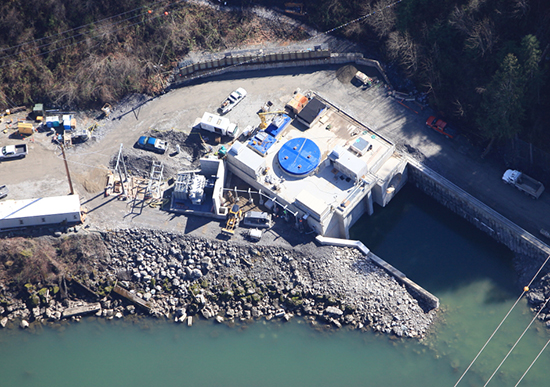|
Subscribe / Renew |
|
|
Contact Us |
|
| ► Subscribe to our Free Weekly Newsletter | |
| home | Welcome, sign in or click here to subscribe. | login |
Construction
| |
 |
May 9, 2014
Lower Baker Unit 4 Powerhouse
PUBLIC WORKS: CIVIL PROJECTS (TIE)
Location: Concrete
Owner/developer: Puget Sound Energy
Project team: PCL Construction Services, general and concrete contractor; Black & Veatch, structural engineer; Concrete Nor’west, ready-mix supplier
The Lower Baker Unit 4 Powerhouse is a subterranean 30-megawatt hydro turbine generator powerhouse connected by a new 15-foot-diameter tunnel.
The project is located on the Baker River in Skagit County, partially within the town of Concrete.
Design and construction was split into four phases.
Phase I consisted of site utility relocations to make way for the new powerhouse. Following utility relocations a series of secant wall piles were installed into bedrock to form a watertight (lean mix concrete curtain) wall around the powerhouse construction.
Once the secants were completed excavation began in the area within the walls. The east secant wall provided the “turn under” location (portal) to begin the tunneling work included in the construction of Phase II.
Phase III construction included the concrete powerhouse structure, and Phase IV construction included the permanent secant concrete tailrace entry to the Lower Baker River.
The concrete powerhouse included four main below-grade levels with the lowest level reaching 20 feet below the river. The footprint of the powerhouse was approximately 6,000 square feet, yet the project consumed 12,000 cubic yards of concrete between the powerhouse structure and tunnel.
The concrete floors and perimeter walls of the powerhouse are 36 inches thick. The perimeter walls were single-side formed against the secant piles with a PVC water stop and keyway at each construction joint to reduce water seepage. The walls and floors remained exposed as a finished product.
Due to the precision required of the turbine and generator components, placement of concrete required specialized methods and mix-design engineering to counteract potential alkali silica reactivity (ASR) of the aggregate and cement in the mix. Over time, ASR in concrete has potential to move embedded components, which can be counteracted by use of fly ash.
The ready-mix supplier worked with the design-build team to develop this specialized mix utilizing the aggregates available in the region, ultimately resulting in mix containing 30 percent fly ash.
Additionally, concrete was placed in 1-foot lifts every eight hours around critical embedded components as a method to further control and minimize the effects of buoyancy and heat of hydration moving the embed. The largest embed, in excess of 60,000 pounds, was the scroll case, the foundation for turbine component erection.
This pressure vessel embed was pressurized prior to concrete encasement to reduce skin friction and simulate operating pressures of the component during use. The vessel remained pressurized at 150 pounds per square inch with circulated reservoir water through the use of two high-pressure pumps over a three-week period until all the lifts were cast around the scroll case within 0.0196 inches of tolerance.
Utilizing these practices, the design-build team met these significant tolerances, providing a high-quality concrete product for the client.
Other Stories:
- Revised structural concrete ‘cookbook’ will follow a simpler recipe
- Liberty Lake roundabout
- Cascade Middle School
- Estancio I
- Grand Ridge Plaza blocks 2, 3, 17 and 18
- Hendricks residence
- Diamond S Ranch
- Satus Creek Bridge replacement
- Husky Stadium renovation
- Clearwater Casino parking garage
- Providence Medical Office Building at Hawks Prairie
- Chief Joseph Fish Hatchery
- The Martin apartments



